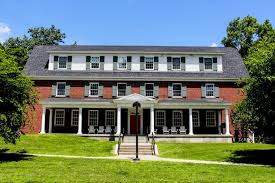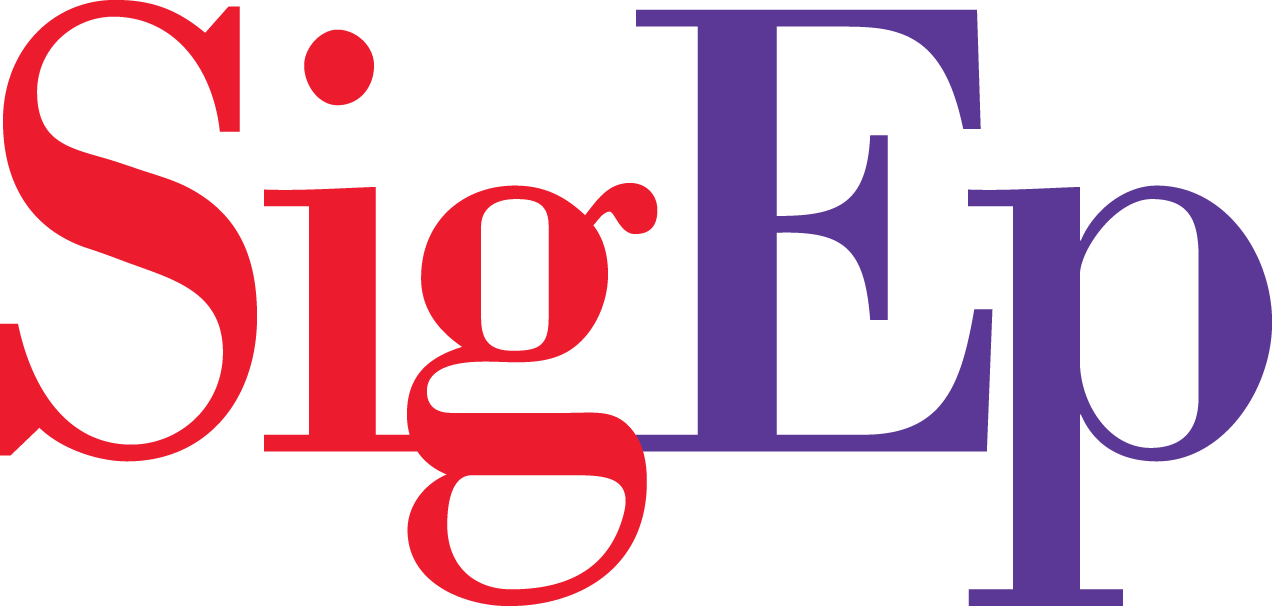History
 In The Beginning: Omicron Pi Sigma
In The Beginning: Omicron Pi Sigma
It was February 6, 1908 when Francis Moncrief Qua and John Albert Randall, two freshmen in the Class of 1911, decided that the fraternities of Dartmouth College did not offer the kind of brotherhood they sought. They carefully delineated plans for a new fraternity, considering the men who were to be invited to join them in the founding of a new brotherhood. From the start they hoped for eventual admittance to the local Interfraternity Council and ultimately affiliation with some national organization.
The next day, Clifton A. Orcutt '11 and Frank E. Wheatley '11 were apprised of the preliminary plans and joined with Qua and Randall in laying the foundation for the fraternity. The new local grew rapidly, and at an early meeting the name Omicron Pi Sigma was adopted.Orcutt and Wheatley were named to secure rooms for the house, and Room 17 of The Tavern Block was soon procured.
Soon after, Qua and Phineas W. Whiting '11 drafted a constitution, adopted April 22, 1908, in which the objectives of Omicron Pi Sigma were stated as "the friendly association of its members in the bonds of fraternity and the affording of intellectual opportunities for the members." At the same meeting the first officers of the Fraternity were elected: Francis M. Qua '11, president; John A. Randall '11, vice-president; and Clifton A. Orcutt '11, secretary-treasurer.
In June the 20-foot by 16-foot Room 17 was vacated and the house was moved to larger quarters in the one-story addition at the rear of The Tavern. This hall was originally designed for a lodge room and suited the purposes of the brotherhood ideally.
Following the College's summer recess, the Fraternity first met on October 14. Shortly thereafter, Assistant Professor of Greek and Classical Philosophy Richard W. Husband was bid by the Fraternity, followed by Lindley Richard Dean '09, who was elected second president of the house at the following meeting. Francis M. Qua was named vice-president; Clifton A. Orcutt, secretary; and Clifton T. Edgerly '11, treasurer, at the same meeting. The Dartmouth College newspaper, The Dartmouth, noted in its November 6, 1908 issue the recognition of this new fraternity:
A new fraternity, Omicron Pi Sigma, has recently been formed, and was recognized by the Interfraternity Council at a meeting Wednesday night, the matter having been referred to the different fraternities. The following are members: 1909--William Ashworth, Charles W. Cartland, Lindley R. Dean; 1910--Irving O. Scott; 1911--Clifton T. Edgerly, Clifton A. Orcutt, Howard S. Parlin, Harold W. Pease, Francis M. Qua, John A. Randall, Harlin P. Sanborn, Arthur F. Sargent, John R. Scotford, and Phineas W. Whiting.
Soon after this recognition, Qua was appointed to "treat with the national fraternity, Sigma Phi Epsilon, concerning a charter," and Dean and Irving O. Scott were elected as representatives to the Interfraternity Council.
The First Chapter of Sigma Phi Epsilon in New Hampshire
In December, the large hall was given up because of financial difficulties and the Fraternity moved to Room 16 in The Tavern where, on Saturday, March 27, 1909, a special meeting was called at which time the local agreed to join Sigma Phi Epsilon. Said The Dartmouth on April 16, 1909: "Omicron Pi Sigma, a local fraternity, has been granted a charter by the national fraternity of Sigma Phi Epsilon. The date for the installation has not been definitely set, nor is it known if all the members of the local fraternity will join Sigma Phi Epsilon."
Almost a week later, on Saturday, April 24, 1909, the New Hampshire Alpha Chapter of the Sigma Phi Epsilon Fraternity was installed in Room 16 of The Tavern Block. National Founder and Grand Secretary William Lazell Phillips conducted the initiations, which started after the delegates arrived on the two o'clock train. Members of the New York Alpha of Syracuse University, Mssrs. Perkins and Carmin, and a delegation from the Vermont Alpha Chapter at Norwich University assisted in the ceremonies, which ran through the afternoon and evening of April 24. Initiated at the ritual were Prof. Richard Husband; '09--William Ashworth, Lindley Richard Dean, Charles Wallingford Cartland; '10--Irving Osgood Scott; '11--Clifton Tisdale Edgerly, Clifton Ainslee Orcutt, Howard Shedd Parlin, Harold Warren Pease, Francis Moncrief Qua, John Albert Randall, Arthur Forrest Sargent, Phineas Wescott Whiting; '12--David Lawson Dorward, Stanley Plat Lovell, Arthur Thayer Cobb, and Irvin James Goss.
A special meeting of the new chapter was held a noon the next day and Brother Phillips and the other delegates departed that afternoon. Francis Qua was appointed sigma of the Chapter and headed the list of new officers, as the Chapter settled down to the ordinary affairs of fraternity life, including the formation of a baseball team (which lost its first game to Sigma Chi, 9-5) and the manufacture of a large green lizard to enter in the Junior Week Society Circus.
According to Chapter records, "at a special meeting, June 3, under the shadow of total lunar eclipse, Frank E. Wheatley '11... was initiated into the Fraternity." Wheatley was the only founder of the Chapter not initiated on April 24, 1909.
A few years later the Chapter moved to larger quarters in the Bridgeman Block in the center of the Hanover business district. There the fraternity remained until the house built by Frank Sherman in 1878 at 37 North Main Street (presently the Sherman Personnel House for the Mary Hitchcock Hospital) was acquired in 1918.
This property was extensively remodeled in the years 1918-1941 and was only sold by the Alumni Corporation in the fall of 1943 when the College closed all fraternities for the duration of World War II.
On Sunday afternoon, March 17, 1946, ten undergraduates and four alumni met in 103 Richardson Hall to rejuvenate the Chapter. Successive meetings were held in that room, in 310 Massachusetts Hall, 4 Wigwam Circle, and 107 McNutt Hall until the Chapter was moved into the house at 8 School Street early in February 1947.
Although adequate for a while, this building proved too small and too far from the main fraternity activity of the campus. In 1953, therefore, the Chapter rented the former Clarke School dormitory at 11 Webster Avenue on "Fraternity Row" from the College and moved that fall to the present quarters of the Fraternity.
The house was remodeled, mostly by the active brothers, and the construction of an addition was quickly considered. Definite plans for this wing were made in 1956 and construction began in September 1958, the addition being completed in time for the Chapter's Fiftieth anniversary in Sigma Phi Epsilon on April 24, 1959.
Separation: The Makings of Sigma Theta Epsilon
The school year of 1966-67 was a significant and turbulent time for the Chapter. Attaining the coveted First Prize for combined achievement awarded by the Interfraternity Council, SigEp earned the honor for its third place finish in administration, fourth in scholastics, first in special events (the IFC play contest, Hums, snow sculpture, etc.) and eleventh in athletics. That winter SigEp was awarded the Outstanding Chapter Award by the Grand Chapter Conclave making it one of nine out of 162 chapters in the United States chosen for "high merit" in all phases of fraternity.
At the same time, however, the question of local autonomy was brought into the open; discussion between brothers and alumni ensued during the winter months. A variety of factors contributed to the chapter's decision to disaffiliate with the National: feeling that the strength of Sip Ep rested in an individual house at Dartmouth College, rather than in a national organization; noting the "archaic and hypocritical" practices and rituals of the National; and basic dissatisfaction with the communication and associative benefits of the National. So on January 18, 1967, under president Charles K. Coe '65, the historic vote was taken to sever ties with the national fraternity of Sigma Phi Epsilon. Becoming the twelfth local on campus, brothers hoped to "further the trend" of national disaffiliation in this era of general corporate disenchantment.
With a vote of confidence in an Alumni ballot of the brothers' action, on February 1, 1967, the brotherhood approved the adoption of a new name, Sigma Theta Epsilon. The new double-eagle crest was designed by John H. Pilling in May 1967.
The now local SigEp still enjoyed the strength of its fraternity though, and in the summer of 1968 they were again the number one house on campus. Though upset over the loss of a fine chapter, the National and Sigma Theta Epsilon finally settled an amicable split, leaving the path open for return at any time.
For the next decade Sigma Theta Epsilon remained convicted to its independence while consistently ranking at the top of the other 23 houses on campus. The National, however, periodically approached SigEp with offers to rejoin but it was not until January 1981 that sentiments allowed Chuck White, the National fraternity's executive director, and Bruce Hasenkamp '60, representing the board of directors, to meet and talk with the brothers of SigEp and give a presentation before the house.
Renewal
The National had made changes, placing more emphasis on the individual chapters and offering an attractive, comprehensive housing improvement program. On February 18, 1981, President Brian Goeselt '82 called for a vote; the unanimous decision was to rejoin what was then the second largest national fraternity in the United States. Officially reinstalled April 24, 1981, Sigma Phi Epsilon quickly began house improvements which had been neglected for a while.
In 1992, Dartmouth SigEp became a pilot chapter for the implementation of the Balanced Man Program (BMP), a national brotherhood development program conceived at the 1991 Conclave to “build better Brothers and leaders, not better pledges.” The program’s emphasis on leadership, service learning, and experience-based learning had an immediate positive effect and recruitment jumped from fewer than 10 men a year to more than 30. At the 1999 National Conclave, the NH Alpha chapter won the Buchanan Cup recognizing excellence in all aspects of chapter operations. This was the first in a string of Buchanan Cup wins culminating with a Gold cup at the 2009 Conclave signifying a Decade of Excellence.
In 2009, the Chapter celebrated the 100th Anniversary of its founding with a grand Centennial celebration during Dartmouth’s Homecoming. Alumni and undergraduates toasted a century of brotherhood and discussed the centennial mission of “Redefining Dartmouth Fraternity.”
While plans to do something about the physical structure at 11 Webster Avenue had been in discussion for several years, the Centennial celebration became the catalyst for a capital campaign to raise money for a new chapter house that would support the goal of being the best fraternity on campus. The “Campaign for SigEp at Dartmouth,” led by Bob Wetzel ’76, with honorary chairmen Bruce Hasenkamp ’60 and Ed Haldeman ’70, kicked off in 2010 and the support for the “dear old fraternity” was clear from the start. Simultaneously, a Housing Committee led by AVC President Keith Jacobsen ’97, began work on the design and construction of a new house. The old house was razed right after Dartmouth Commencement in June 2010, and a beautiful new Chapter house with 26 beds was ready for the undergraduates to move in during the Spring of 2011.
In 2018, after repeated instances of student misconduct and conflict between the undergraduate chapter, AVC, and National organization, the chapter was suspended and derecognized, with the dissolution of the current undergraduate membership following soon thereafter. A lease of the empty facility at 11 Webster Avenue was negotiated with the College in order to make productive use of the facility in the interim, which hosted a Living Learning Community called The Thought Project, proving that such an organization can be successful on Webster Avenue. After delays brought on by the COVID-19 pandemic, the fraternity plans to resume its activities in the 2021-2022 school year, and assume management of our chapter house in Fall 2022.
Among SigEps are many men who have brought distinction and honor to themselves, their Fraternity, and their College, including the late James V. Forrestal '15, first secretary of defense; D. Basil O'Conner Jr. '12, president of the National Foundation and former law partner of President Franklin D. Roosevelt; Ambassador to Greece Ellis O. Briggs '21; Theodore S. Geisel '25, the Dr. Seuss of children's book fame; Whitney H. Eastman '10, past grand president of the National Fraternity, retired vice-president of General Mills, member of the executive committee of the Crusade for Freedom, life member of the National Board of the Boy Scouts of America, and recipient of the Sigma Phi Epsilon Order of the Golden Heart; and Ambassador to Ethiopia Don C. Bliss Jr. '18; Former Chairman of Dartmouth’s Board of Trustees and CEO of Fannie Mae Ed Haldeman ’70; Technology Crossover Ventures cofounder Rick Kimball ’78; Senior Vice President and General Counsel of Major League Baseball Tom Ostertag ’78; and Tony-nominee Broadway, film, and television actor David Harbour ’97.







